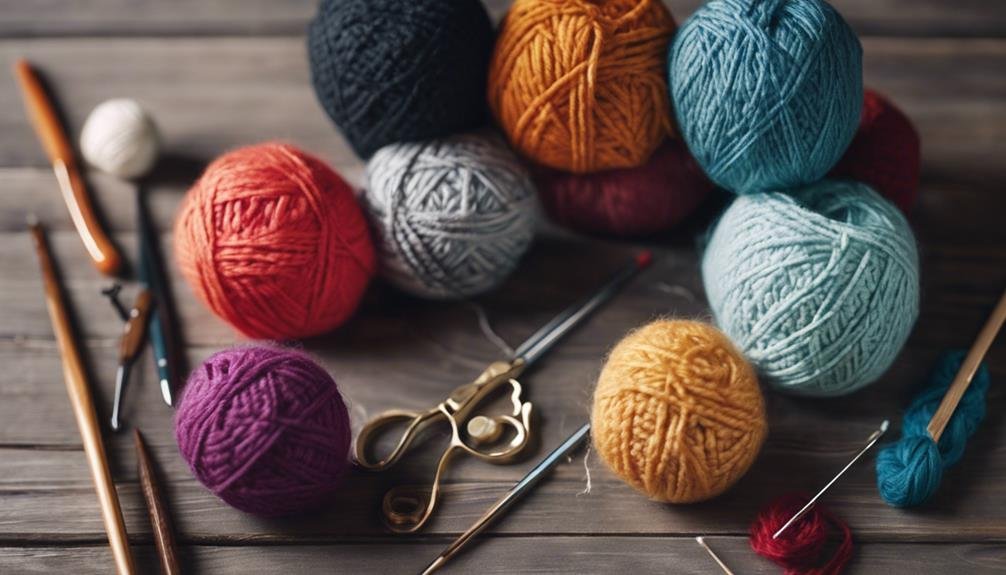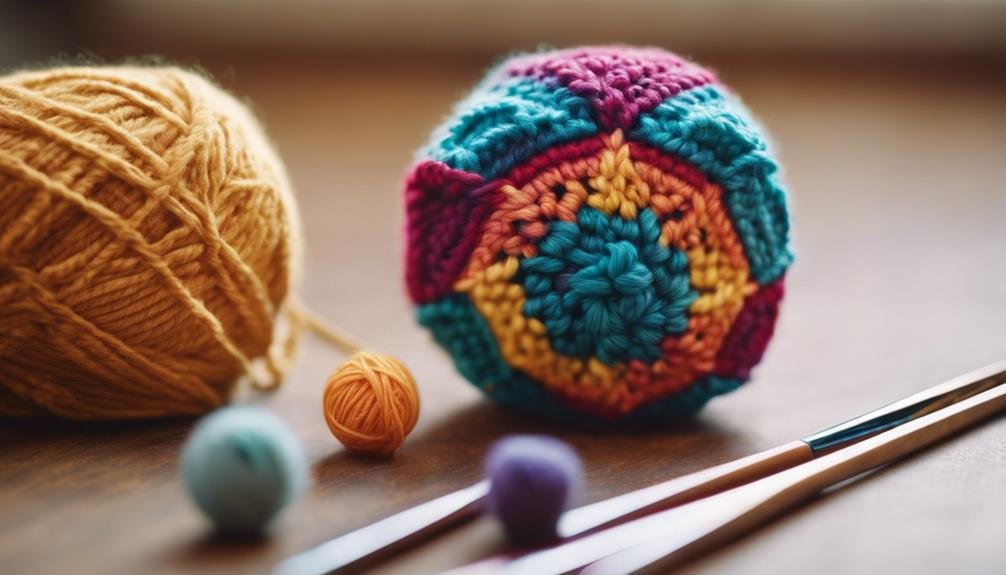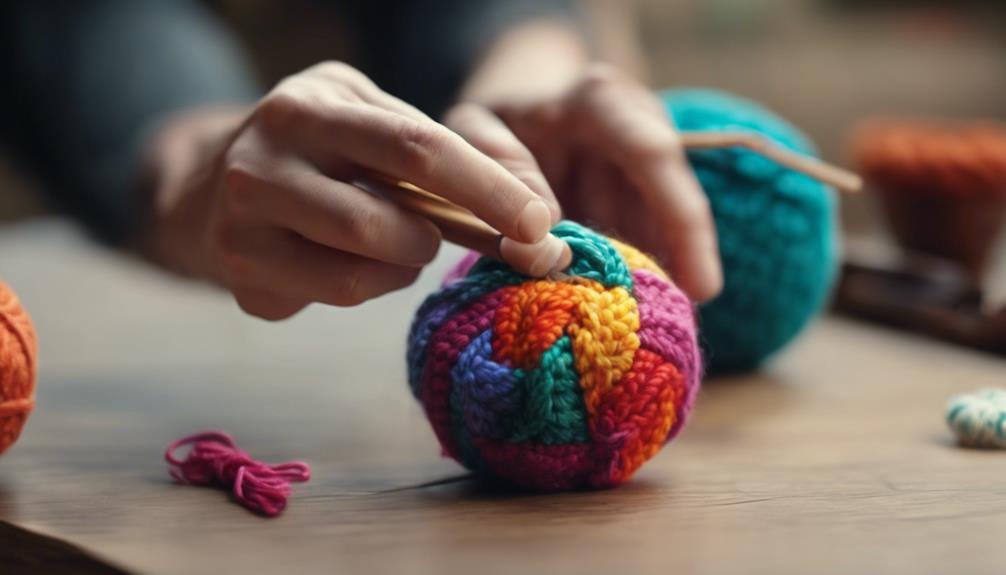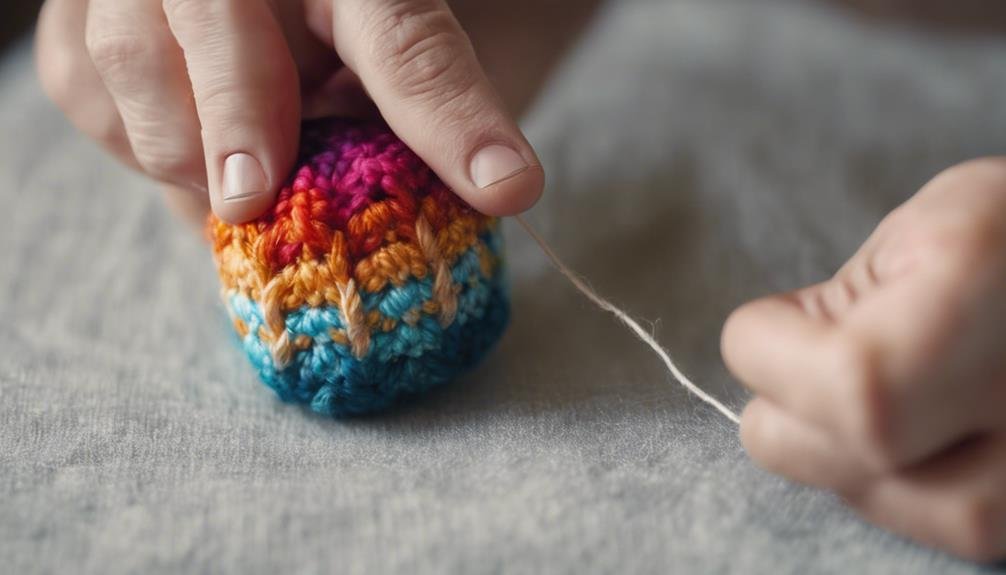As you begin creating your own Hacky Sack crochet pattern, selecting yarn and hook size isn’t just important for aesthetics; it’s vital for ensuring the durability and functionality of your finished product. You’ll want to think about synthetic fibers like acrylic for their resilience and ease of maintenance. You may not realize how the texture of the yarn can impact the sack’s performance during play. Moreover, choosing and using the appropriate hook size can affect the tightness of the stitches, which in turn influences the sack’s shape and feel. Let’s explore how these elements combine to create a Hacky Sack that looks good and performs well.
Key Takeaways
- Begin with a magic circle and crochet 6 single stitches to form the base.
- Gradually increase stitches in a spiral pattern to shape the hacky sack.
- Use synthetic yarn for durability and a mix of grain fillings for weight.
- Decrease stitches toward the top and secure the closure to contain filling.
- Reinforce the final seam with slip stitches to enhance strength and durability.
Choosing the Right Yarn

The right yarn is essential for crafting a durable and playable hacky sack. Yarn durability and texture variety are key factors influencing your project’s success. When browsing for materials, pay close attention to the yarn’s composition. Synthetic fibers, like acrylic, are often sturdy and maintain shape under the constant impact of kicks and tosses. They resist wear and tear, ensuring your hacky sack holds up over time.
But don’t overlook the importance of texture variety. A smoother yarn might be easier to work with and can create a tighter, more uniform stitch. However, a yarn with some texture can provide a better grip, making it easier to control the hacky sack during play. This can be particularly useful if you aim for a hacky sack that won’t easily slip out of your foot’s grasp.
Explore options like cotton blends, which balance smoothness and grip. You’re aiming for a yarn that lasts and enhances playability. Remember, your choice affects how the hacky sack performs, so choose wisely to optimize durability and function.
Selecting the Best Hook Size
The appropriate hook size is essential for achieving tight, consistent stitches in your hacky sack. You’ll want to choose a hook that complements the yarn weight you’ve selected, generally opting for a smaller size to ensure the filled hacky sack remains firm and durable.
When considering hook material, aluminum and steel hooks are excellent choices. They’re smooth, allowing yarn to glide effortlessly as you crochet, which is critical for maintaining an even tension throughout your project. Additionally, these materials are durable and resist bending, guaranteeing that you can use them for multiple projects.
Don’t overlook the importance of ergonomic handles on your crochet hooks, especially if you’re working on your hacky sack for extended periods. Ergonomic handles are designed to fit comfortably in your hand, reducing strain and fatigue. This is particularly beneficial when working with tighter stitches, requiring more effort and precision.
Lastly, experiment with a few hook sizes before settling on the best one. It’s not just about the tightness of the stitches; it’s also about how the hook feels in your hand and how it interacts with the yarn. Finding the right combination will make your crochet experience much more enjoyable.
Understanding Basic Crochet Stitches

Now that you’ve chosen your hook let’s focus on mastering the basic crochet stitches you’ll need for your hacky sack. It’s important to understand how to manipulate your crochet tools effectively. The primary stitches include the chain stitch (ch), single crochet (sc), and slip stitch (sl st). Each has its role in shaping and texturing your project.
First, practice the chain stitch, as it’s the foundation for most crochet projects. Hold your hook and use your fingers to regulate stitch tension. This control guarantees even stitches and a professional-looking finished fabric.
Next, a single crochet is essential for building the body of the hacky sack. Insert your hook into a chain stitch, yarn over, and pull through to create a loop. Yarn over again and pull through both loops on your hook. This stitch is simple but versatile, forming a tight, sturdy fabric ideal for a hacky sack that’ll withstand frequent use.
Starting Your Hacky Sack Base
Create a magic circle with six single crochet stitches to kick off your hacky sack project. This initial step is important as it sets the foundation for your hacky sack’s base dimensions. Ensure you maintain a consistent stitch tightness; this guarantees your hacky sack’s durability and shape retention. As you work, you’ll want to check that your stitches are neither too tight nor too loose, which can substantially impact the final product.
| Step | Details |
|---|---|
| 1. Create Base | Start with a magic circle and 6 stitches. |
| 2. Maintain Tightness | Keep stitches even for shape retention. |
| 3. Assess Dimensions | Aim for a base about 1.5 inches in diameter. |
After your initial circle, you’ll continue to work in rounds, gradually increasing the number of stitches to achieve the desired base dimensions. Measuring the diameter after a few rounds is helpful to see if you’re on track. Remember, the base sets the tone for the entire project, so it’s worth taking your time to get it right.
Shaping the Body of the Hacky Sack

Once you’ve finished the base, shape the body by gradually increasing the number of stitches in each round. This method helps create a spherical shape essential for a well-formed hacky sack. Pay attention to your stitch tension as you expand the sack’s body. Consistent tension guarantees that the stitches are neither too tight nor loose, contributing to the sack’s durability and shape retention.
As you work through the rounds, contemplate using seam reinforcement techniques. This involves reinforcing each round with a slip stitch, strengthening the hacky sack and helps maintain its shape during vigorous play. Remember, a well-crafted body is important for a hacky sack that performs well and withstands repeated use.
To keep you on track, here are some key points to keep in mind:
- Keep your stitches even: Uniform stitches contribute to the overall aesthetics and structural integrity.
- Gradually increase: Add stitches evenly in each round to maintain a smooth, spherical shape.
- Monitor tension: Consistent stitch tension is essential for the hacky sack’s durability.
- Reinforce seams: Use slip stitches at the end of rounds for added strength.
- Check your progress: Frequently assess the shape and adjust your technique if necessary.
Filling Options for Weight and Feel
After shaping the body of your hacky sack, you’ll need to ponder the filling that best suits your desired weight and feel. Traditional fillings like sand or plastic pellets work well, but let’s explore some grain alternatives that can enhance your sack’s performance while being mindful of the environmental impact.
Grains such as millet, rice, or wheat are excellent natural fillers. They’re readily available and biodegradable, reducing your environmental footprint. Millet, in particular, is small and dense, giving your hacky sack a good heft without making it too hard. It’s perfect if you aim for a sack with a medium bounce and solid control during play.
Rice, while slightly lighter than millet, offers a softer feel and a bit more bounce. This makes it ideal if you prefer a hacky sack that’s easier on your feet and great for beginners. Wheat, with a weight similar to millet, offers durability and a consistent performance, particularly outdoors.
Consider mixing these grains to customize the weight and texture. Adjusting the proportions can help you balance your playing style perfectly, ensuring your hacky sack is as unique as your crochet pattern.
Closing and Securing the Hacky Sack

Now that your hacky sack’s body is complete, it’s important to securely close it to prevent the filling from escaping during play. Stitch reinforcement and proper knot types guarantee durability and a well-formed shape. Here’s how you can achieve a secure closure:
- Tighten the Stitches: Gradually decrease the size of your crochet stitches as you near the closure point. This compacts the fabric, making it less likely for fillings to slip out.
- Choose the Right Knot Type: Use a surgeon’s knot for its reliability and strength. This knot will hold tightly under the constant pressure of kicks and tosses.
- Stitch Reinforcement: Go over the closing stitches multiple times. This redundancy adds an extra layer of security.
- Leave a Small Opening: Ensure all your filling is adjusted and evenly distributed before completely closing. Then, continue stitching.
- Secure the Final Loop: After your final stitch, pull the yarn through the last loop and tighten. Then, weave the end back through several stitches before cutting off the excess.
These steps will help ensure your hacky sack remains intact and enjoyable for countless games.
Adding Personalized Color Patterns
Having secured your hacky sack, you can now add a splash of personality by incorporating personalized color patterns. Choosing the right colors isn’t just about aesthetics; it’s about expressing yourself. Color symbolism plays a key role here. For instance, red can evoke energy and passion, while blue might calm the mind. Consider what each session with your hacky sack means to you, and pick colors that resonate with those feelings.
Next, consider using gradient techniques to make your hacky sack visually striking. This method involves blending colors gradually from one to another, creating a smooth shift. You’ll start with the darkest shade and slowly integrate lighter shades as you crochet around the sack. This technique enhances the look and adds a unique touch that can’t be easily replicated.
Don’t be afraid to experiment with bold contrasts or soft hues depending on your mood or the statement you want to make. Remember, your hacky sack is a reflection of your creativity and spirit. By personalizing it with your chosen colors and patterns, you’re not just crafting a toy but an expression of your individuality. Let your colors tell your story.
Maintenance and Care Tips

Regular cleaning and proper storage are crucial to keeping your hacky sack in top condition. You’ll want to determine the cleaning frequency based on how often you use it. A weekly clean might be necessary if you play daily, whereas less frequent use might require only bi-weekly attention.
Here are some practical tips to guarantee your hacky sack stays in great shape:
- Check for Loose Threads: Inspect your hacky sack before and after each use for any loose threads or signs of wear and tear. Snip any loose threads with scissors and patch small holes to prevent them from enlarging.
- Wash Gently: Hand wash your hacky sack using mild soap and warm water. Avoid harsh detergents and hot water, which can damage the crochet fibers.
- Air Dry Thoroughly: After washing, let your hacky sack air dry completely before using or storing it again. This prevents mold and odor buildup.
- Avoid Direct Sunlight: Keep your hacky sack out of direct sunlight when drying and storing to prevent the colors from fading.
- Storage Solutions: Store your hacky sack in a cool, dry place. A fabric bag or box can protect it from dust and moisture when not in use.
Conclusion
Now that you’ve mastered crocheting your Hacky Sack, pick durable yarn and the right hook size for a sturdy build.
Master those basic stitches, shape them carefully, and choose a filling that gives the perfect weight.
Seal it tightly, add your personal touch with colors, and take care of it with gentle washing.
You’ll have a custom Hacky Sack set for endless fun.
Keep practicing, and enjoy your creation!
FAQs
What type of yarn is best for crocheting a durable Hacky Sack?
Synthetic fibers like acrylic are ideal for their resilience and ease of maintenance, ensuring your Hacky Sack withstands frequent use and maintains its shape over time.
How does the texture of the yarn impact the performance of the Hacky Sack during play?
The texture of the yarn can affect the grip and control of the Hacky Sack, with smoother yarns providing a tighter stitch for better durability, while textured yarns offer improved grip for easier play.
Why is choosing the appropriate hook size important in crocheting a Hacky Sack?
The hook size influences the tightness of the stitches, affecting the shape and feel of the finished product. Selecting the right hook size ensures a well-formed and playable Hacky Sack.

